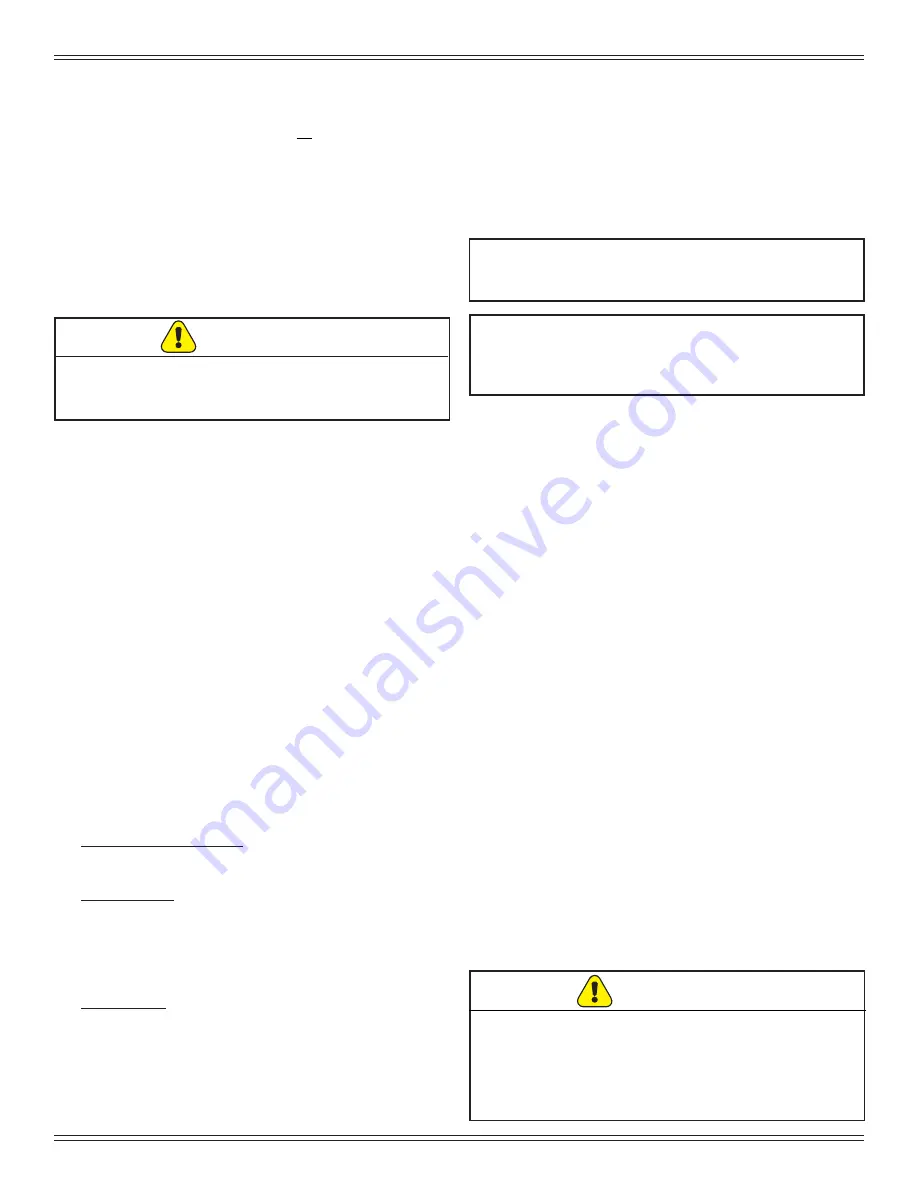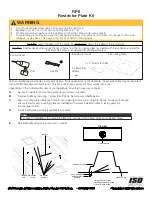
7019-230J
October 23, 2018
15
SANTA FE PELLET INSERT
D. Draft
Draft is the pressure difference needed to vent an
appliance successfully. When an appliance is drafting
successfully, all combustion byproducts are exiting the
home through the chimney.
Install through the warm airspace enclosed by the building
envelope. This helps to produce more draft, especially
during lighting and die-down of the fire.
Considerations for successful draft include:
•
Preventing negative pressure
•
Location of appliance and chimney
NOTICE:
Hearth & Home Technologies assumes no
responsibility for the improper performance of the chimney
system caused by:
•
Inadequate draft due to environmental conditions
• Down drafts
• Tight sealing construction of the structure
•
Mechanical exhausting devices
WARNING
Risk of Asphyxiation!
Negative pressure can cause spillage of combustion
fumes and soot.
E. Chimney and Exhaust Connection
1. Chimney & Connector
:
Use 3 or 4 inch (76-102mm)
diameter type “L” or “PL” venting system. It can be
vented vertically or horizontally.
2. Mobile Home:
Approved for all Listed pellet vent. If
using the 3 inch (76mm) vertical Top Vent Adapter Kit
or the 3 to 6 inch (76-152mm) Top Vent Offset Adapter,
use Listed double wall flue connector. A Quadra-Fire
Outside Air Kit must be used with manufactured home
installations.
3. Residential:
The 3 inch (76mm) vertical Top Vent
Adapter Kit and the 3 to 6 inch (76-152mm) Top Vent
Offset Adapter are tested to use 24 gauge single wall
flue connector or Listed double wall flue connector to
Class A Listed metal chimneys, or masonry chimneys
meeting International Residential Code standards for
solid fuel appliances.
To minimize the effects of negative air pressure:
•
Install the outside air kit with the intake facing prevailing
winds during the heating season
• Ensure adequate outdoor air for all
combustion
appliances and exhaust equipment
• Ensure furnace and air conditioning return vents are
not located in the immediate vicinity of the appliance
• Avoid installing the appliance near doors, walkways or
small isolated spaces
•
Recessed lighting should be a “sealed can” design
• Attic hatches weather stripped or sealed
•
Attic mounted duct work and air handler joints and
seams taped or sealed
4. INSTALL VENT AT CLEARANCES SPECIFIED BY THE
VENT MANUFACTURER.
5. Secure exhaust venting system to the appliance with
at least 3 screws. Also secure all connector pipe joints
with at least 3 screws through each joint.
6. DO NOT INSTALL A FLUE DAMPER IN THE
EXHAUST VENTING SYSTEM OF THIS Appliance.
7.
DO NOT CONNECT THIS Appliance TO A CHIMNEY
FLUE SERVING ANOTHER APPLIANCE.
1.
Termination must exhaust above air inlet elevation.
2.
Distance from
doors and opening windows, or gravity
or ventilation air inlets into building:
a.
Not less than 48 inches (1.2m) below;
b. Not less than 48 inches (1.2m) horizontally from;
c.
Not less than 12 inches (305mm) above.
3.
Distance from permanently closed windows;
a.
Not less than 12 inches (305mm) below;
horizontally from or above.
4.
Distance between
bottom of termination and grade
should be 12 inches (305mm) minimum. This is
conditional upon plants in the area, and nature of grade
surface. The grade surface must be a non-combustible
material (i.e., rock, dirt). The grade surface must not
be lawn. Distance between bottom of termination and
public walkway should be 7 feet (2.13m) minimum.
5. Distance to combustible
materials must be 24 inches
(610mm) minimum. This includes adjacent buildings,
fences, protruding parts of the structure, roof overhang,
plants and shrubs, etc.
6. Termination Cap Location (Home Electrical Service)
•
Side-to-side clearance is to be the same as
minimum clearance to vinyl inside corners.
•
Clearance of a termination cap below electrical
service shall be the same as minimum clearance to
vinyl soffits.
•
Clearance of a termination cap above electrical
service will be 12 inches (305mm) minimum.
•
Location of the vent termination must not obstruct
or interfere with access to the electrical service.
F. Venting Termination Requirements
NOTE:
If burning shelled field corn, you must use
approved venting specifically designed for
corn. Follow the instructions from the venting
manufacturer.
NOTE:
All pipe must be welded seam pipe whenever
possible. Seal pipe joints with high temperature
silicone (500°F [260°C] minimum rated only).
DO NOT
terminate vent in any enclosed or semi-
enclosed area such as a carport, garage, attic, crawl
space, under a sun deck or porch, narrow walkway or
closely fenced area, or any location that can build up
a concentration of fumes such as a stairwell, covered
breezeway, etc.
CAUTION
















































